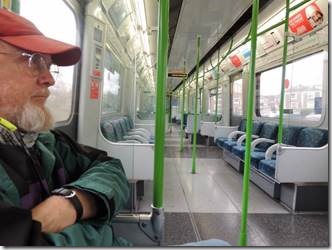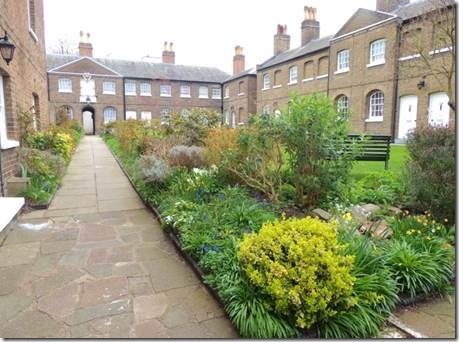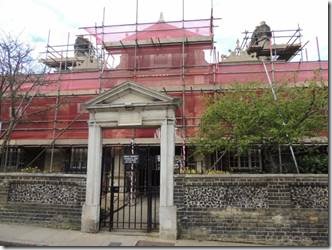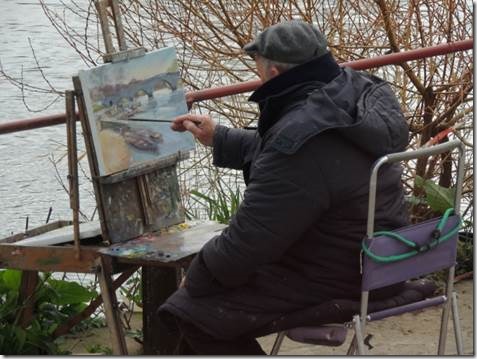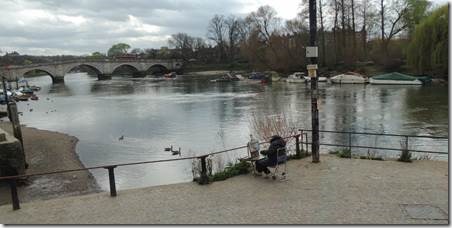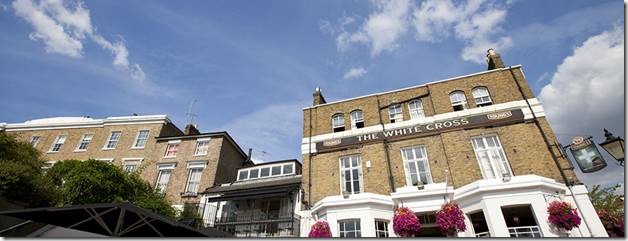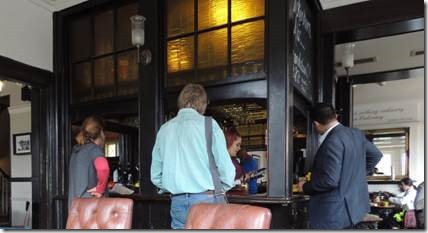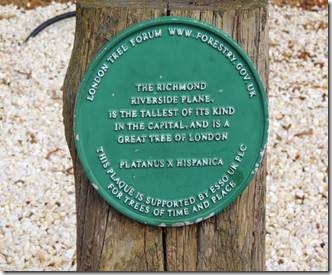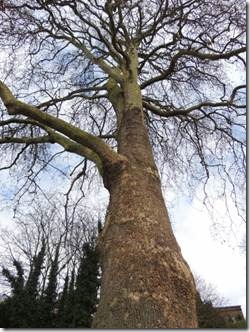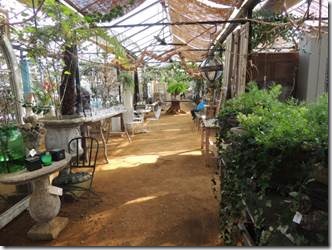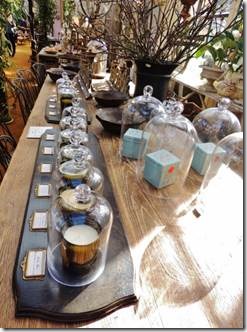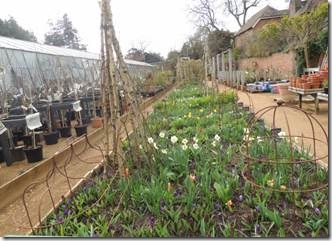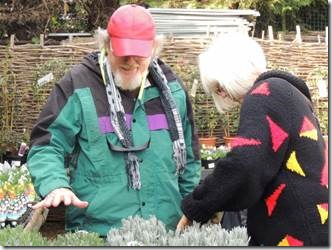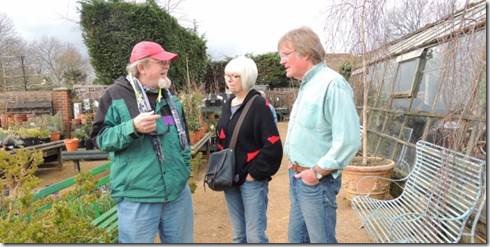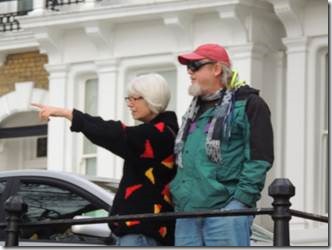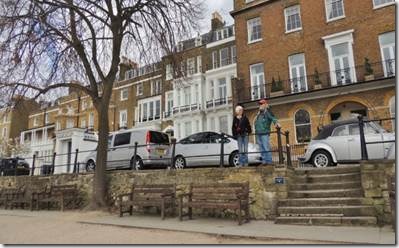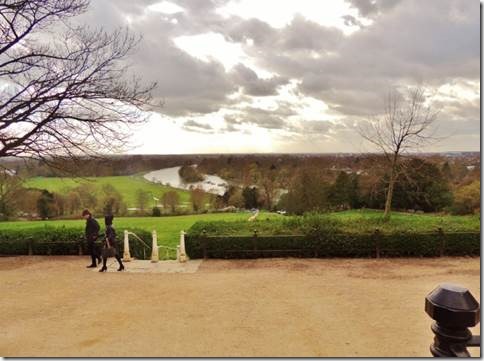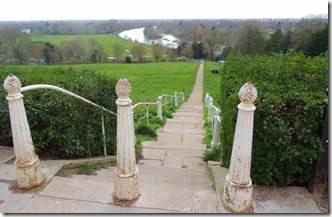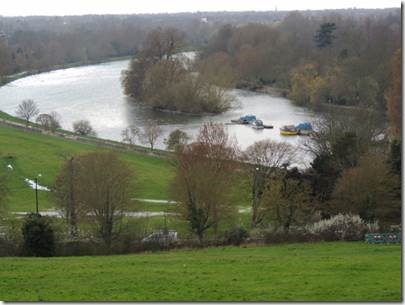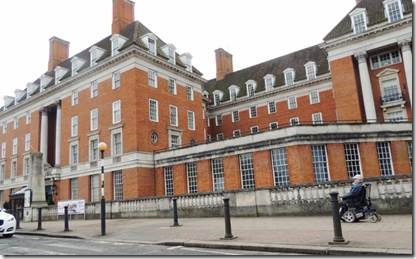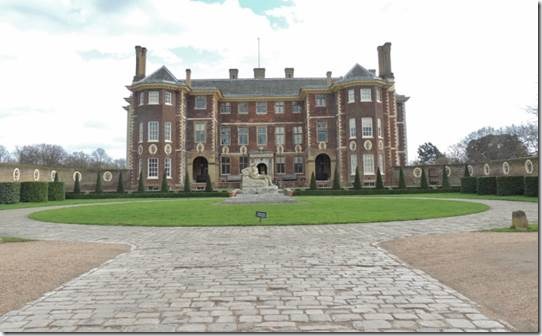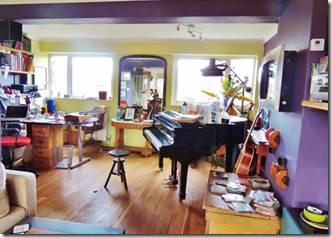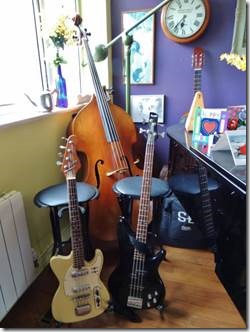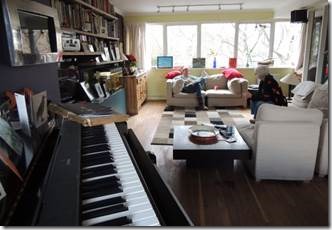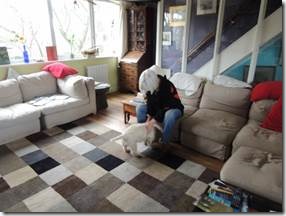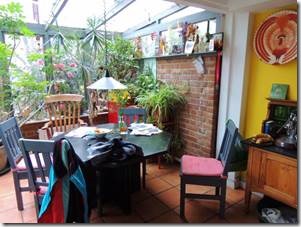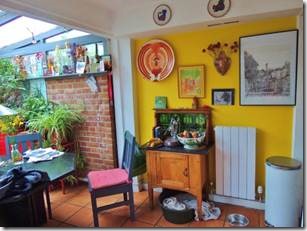Cheers,
Soon I’ll be writing from Ipswich! We leave SKD mid-morning Thursday for the 2 day passage. Maybe with the slower pace of Ipswich I’ll catch up on some of my London stories.
This email is about our visit with Jane and Rick (the 3rd Jane) in Richmond. Later this morning Mary, Rick, Randal and I are off for an Alternative Art Walking tour I discovered last week. Hope the rain holds off.
Ru
|
Randal and I were the only ones in our train car by the time we arrived in Richmond, “the end of the District line.” It was just about noon so not the busy commuter time of day. |
|
I had told Jane I was interested in almshouses so they were the first stop during our “tour de Richmond with Jane and Rick.” Michel’s Almshouses Michel’s Almshouses were founded in 1695 by Humphrey Michel. This charity owned property in The Vineyard and, at one time, land in Maiden Lane, which now forms part of the stage of the Adelphi Theatre. On his uncle’s death John Michel gave a further endowment to the charity. In 1727 William Smithet bequeathed to the charity a significant endowment of three houses and land in Kew Foot Road. On part of this land Michel’s Row, Rosedale Road and Benn’s Cottages were built. The original block of ten almshouses fronting The Vineyard was built in 1696 and rebuilt in 1810. The wing comprising six additional almshouses was added in 1860. A one-bedroom bungalow was built in 1990. The consecrated chapel is used as an almshouse. In 1983 six almshouses, consisting of two studios and four one-bedroom bungalows, were built on the site of Benn’s Cottages and are known as Benn’s Walk. The two studios were combined and converted into a one-bedroom bungalow in 2002. http://www.richmondcharities.org.uk/almshouses/michel-s-almshouses |
|
Bishop Duppa’s Almshouses 1661 Almshouses being rennovated “Bishop Duppa’s Almshouses were founded by Bryan Duppa in 1661. Bryan Duppa, Bishop of Chichester was tutor to Charles, Prince of Wales, later Charles II, at Richmond Palace. Deprived of his bishopric, Bryan Duppa retired to a house on the site of the old Town Hall in Richmond. He promised that, if his pupil were restored to the throne, he would found almshouses in thanksgiving. After the Restoration in 1660, he was appointed Bishop of Winchester. He died in 1662 at his Richmond home. The present almshouses were rebuilt in 1851 in The Vineyard after a deal was struck with James Ewing, owner of Downe House, Richmond Hill whose grounds adjoined the dilapidated almshouses. James Ewing provided the new site and paid for the rebuilding, to a Jacobean design by Thomas Little, in exchange for the old almshouse site. The front arch and gateway was transferred from the original almshouse estate and has survived to this day.” |
|
It was lunch time so we walked through Richmond center to the White Cross Pub. I sneaked some photos of this artist painting the Richmond Bridge. |
|
The White Cross (site’s photo) Rick getting our drinks. “Originally known as the Watermans Arms, the pub was built some time in 1748. It was rebuilt in 1838, and changed its name to The White Cross in 1840. The landlord at the time was Samuel Cross which may explain the name change. The pub is built on the site of the observant Franciscan Friary which was dissolved by Henry VIII in 1534, but there may be some remains of the friary incorporated within our extensive cellars. Have you ever been here during winter and high tide? There were so many of you waiting to get in on the extra high tides we had to invest in some more wellies – even Julie got caught out when she returned from holiday – Rob had to carry Tia (the dog) and left Julie to fend for herself!! If there are no wellies at the waters edge then just give us a call and one of our wonderful team will bring some wellies to you – where better to be stuck than your favourite local – the perfect excuse…” |
|
Tallest of its kind in the Capital |
|
http://petershamnurseries.com/ for a quick walk around this very posh place. |
|
The view from Richmond Hill “The celebrated view of the vale of the Thames from the summit of Richmond Hill has long been the inspiration of writers and artists, both native and foreign.” http://www.richmond.gov.uk/the_view_from_richmond_hill The only view in the country protected by and act of Parliament. “Protected view unveiled to public An act was passed in 1902 to protect the view England’s only view to be protected by an Act of Parliament has been unveiled after a major restoration project. The viewing area from Richmond Hill in south-west London gives a panoramic view of the capital taking in the river Thames, royal parks and palaces. Sir David Attenborough and Jerry Hall officially opened the first phase of the £3.3m restoration, largely funded by the Heritage Lottery. “ http://news.bbc.co.uk/1/hi/england/london/5079602.stm Jane pointing out Heathrow off in the distance and the sky scrapers of London. Mick Jagger lives here as well as Jerry Hall as well, sadly did L’Wren Scott. Pete Townsend lives down the way. Possibly Brad and Angolina live here too. David Attenborough… |
|
Royal Star and Garter Home, Richmond just down from “the view.” “The Star & Garter Committee was established in 1915 under the auspices of the British Red Cross Society to care for the severely disabled young men returning from the battlegrounds of the First World War. It was Queen Mary who first expressed concern for the future of these young men, and Her Majesty charged the British Red Cross Society with the task of finding a ‘permanent haven’ for them. The Auctioneers and Estate Agents Institute purchased the old Star & Garter hotel on Richmond Hill and handed the deeds to Queen Mary who, in turn, entrusted the building to the British Red Cross. The Star & Garter became an independent charity in 1922, in 1979 HM The Queen commanded that the Home would in future be known as The Royal Star & Garter Home, and on 26 June 1990 the Charity was granted a Royal Charter. The Royal Star & Garter Homes has had a long and rich history but has always remained true to its philosophy that ‘ there is no such thing as a hopeless case’ and all the residents, now and then, are cared for with support and therapy. The first 65 residents admitted in 1916 were an average age of 22. Some were able to return home, while others were helped to live fulfilled lives for many years. A new purpose built home was specially designed by Sir Edwin Cooper and funded by the British Women’s Hospital Committee under the auspices of Queen Mary. It was Her Majesty, along with King George V who opened the new home in July 1924. The Charity continued to benefit from its royal links and operated within the magnificent building on top of Richmond Hill until 2013 when we were no longer able to provide the specialist care the residents needed and a state-of-the-art Home was built in Surbiton. |
|
Gift to a “whipping boy.” “It seems an odd notion to us now that a royal court would have kept a child for the purpose of beating him when the crown prince did wrong. That’s just what did happen though. Whipping Boy was an established position at the English court during the Tudor and Stuart monarchies of the 15th and 16th centuries. This may not have been quite as bad as it sounds. The whipping boys weren’t hapless street urchins living a life of torment, but high-born companions to the royal princes. They were educated with the princes and shared many of the privileges of royalty. The downside was that, if the prince did wrong, the whipping boy was punished. It was considered a form of punishment to the prince that someone he cared about was made to suffer.” http://www.phrases.org.uk/meanings/whipping-boy.html tells more about the term and mentions Ham House and William Murray Ham House “A unique 17th-century treasure trove Originally built in 1610, Ham House is the creation of an enterprising courtier, William Murray, and his tenacious daughter Elizabeth. As a boy, William was educated with the young Charles I, taking the role of his whipping boy. Remaining friends as adults, they shared a taste for the latest fashions in architecture, art and interior decoration. William was given the lease of Ham House and its estate as a gift from the King in 1626. http://www.nationaltrust.org.uk/ham-house/history/ This rare and atmospheric Stuart house sits on the banks of the River Thames in Richmond. The house is internationally recognised for its superb collection of paintings, furniture and textiles, largely acquired 400 years ago. It is reputed to be one of the most haunted houses in Britain. Outside, the restored 17th-century garden includes a productive kitchen garden containing many heritage crops, the formal ‘Wilderness’, complete with summerhouses, and many beautiful spots perfect for a picnic.” http://www.nationaltrust.org.uk/ham-house/ Mark Romanek’s film of the Kazuo Ishiguro Never Let Me Go location: ‘Hailsham House’ school: Ham House, Richmond. http://www.movie-locations.com/ |
|
My favorite location in Richmond was Jane and Rick’s home; filled with color and light and all kinds of neat stuff! |

